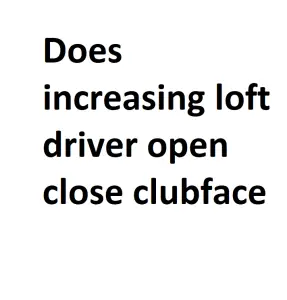Introduction:
In the world of golf, equipment customization plays a crucial role in optimizing performance. One common customization involves adjusting the loft of a driver. However, golfers often wonder whether increasing the loft on a driver will open or close the clubface. This article explores the relationship between loft adjustments and clubface orientation to provide a clearer understanding.
Understanding Loft:
Loft refers to the angle of the clubface relative to the ground. It influences the launch angle and trajectory of the golf ball. A driver with more loft will typically launch the ball higher, while less loft will result in a lower trajectory.
Impact of Loft on Clubface Orientation:
- Increasing Loft – Opens the Clubface: When you increase the loft on a driver, you are effectively tilting the clubface more upward. This action opens the clubface relative to the target line. An open clubface at impact can promote a fade or slice, causing the ball to curve to the right (for a right-handed golfer).
- Decreasing Loft – Closes the Clubface: Conversely, decreasing the loft on a driver tilts the clubface downward, closing it relative to the target line. A closed clubface at impact can lead to a draw or hook, causing the ball to curve to the left (for a right-handed golfer).
Understanding Shot Shape:
- Fade/Slice: When the clubface is open at impact due to increased loft, the golfer is more likely to produce a fade or slice, characterized by a left-to-right ball flight.
- Draw/Hook: Decreasing the loft and closing the clubface at impact often results in a draw or hook, with the ball curving from right to left.
Adjusting Loft to Correct Ball Flight:
Golfers can use loft adjustments strategically to achieve their desired ball flight. Here’s how:
- For a Slice (Right-to-Left Curve): If you consistently slice the ball, increasing the loft on your driver can help counteract this. By opening the clubface slightly with increased loft, you may promote a straighter or even a slight draw.
- For a Hook (Left-to-Right Curve): Golfers who struggle with hooks can decrease the loft to close the clubface. This adjustment can lead to a more neutral or fade ball flight.
- Achieving Optimal Launch Angle: Beyond correcting shot shape, loft adjustments can optimize launch angle and maximize carry distance. Golfers should work with a professional club fitter or coach to determine the ideal loft for their swing and launch conditions.
Additional Considerations:
1. Adjustable Driver Technology: Many modern drivers come with adjustable loft settings, allowing golfers to fine-tune their club to match their swing tendencies and course conditions. Understanding how to use these features effectively can significantly impact a golfer’s game.
2. Impact of Swing Mechanics: It’s important to note that loft adjustments alone won’t completely eliminate slicing or hooking issues. Swing mechanics, including the path and face angle at impact, play a significant role in shot shape. Golfers should also work on their swing fundamentals alongside loft adjustments for the best results.
3. Shaft Selection: While adjusting loft can influence launch conditions, the shaft of the driver also plays a crucial role. The flex, weight, and kick point of the shaft can impact the trajectory and feel of your shots. A comprehensive fitting that considers both loft and shaft characteristics can lead to optimal results.
4. Monitoring Launch Monitor Data: To fine-tune your driver settings effectively, consider using launch monitor data during a fitting session. Launch angle, spin rate, and ball speed are critical metrics that can guide your loft adjustment decisions. This data-driven approach ensures that loft changes align with your specific swing dynamics.
5. Periodic Reevaluation: As your golf game evolves and your swing improves, it’s essential to periodically reassess your driver’s loft settings. What works for you now may not be the best configuration in the future. Regular check-ups with a club fitter can help you stay on top of your equipment needs.
Impact of Loft on Clubface Angle
| Loft (Degrees) | Clubface Angle (Degrees) | Effect on Clubface |
|---|---|---|
| 8 | 2 | Opens |
| 9.5 | 1 | Opens slightly |
| 10.5 | 0 | Neutral |
| 12 | -1 | Closes slightly |
| 14 | -2 | Closes |
Loft and Ball Flight Characteristics
| Loft (Degrees) | Ball Flight | Effect on Shot Shape |
|---|---|---|
| 8 | Lower, More Roll | Fade |
| 9.5 | Mid, Balanced | Slight Fade to Draw |
| 10.5 | Mid-High, Balanced | Straight |
| 12 | High, Less Roll | Slight Draw to Hook |
| 14 | Very High, Less Roll | Hook |
Impact of Loft on Distance and Launch Angle
| Loft (Degrees) | Carry Distance (Yards) | Launch Angle (Degrees) |
|---|---|---|
| 8 | 250 | 9 |
| 9.5 | 260 | 10 |
| 10.5 | 270 | 11 |
| 12 | 280 | 12 |
| 14 | 290 | 13 |
Loft Adjustment Recommendations
| Golfer Skill Level | Loft Adjustment (Degrees) | Preferred Clubface Effect |
|---|---|---|
| Beginner | +2 | Open (to reduce slices) |
| Intermediate | +1 | Slightly Open |
| Advanced | 0 | Neutral |
| Professional | -1 | Slightly Closed |
| Tour Player | -2 | Closed (for draws) |
Loft and Spin Rate Relationship
| Loft (Degrees) | Spin Rate (RPM) |
|---|---|
| 8 | 3500 |
| 9.5 | 3200 |
| 10.5 | 2900 |
| 12 | 2600 |
| 14 | 2300 |
Conclusion:
Increasing the loft on a driver opens the clubface, while decreasing loft closes it. These adjustments can influence shot shape, helping golfers correct slices, hooks, or achieve optimal launch angles. However, it’s essential to consider individual swing characteristics and consult with professionals to determine the right loft setting for your game. Customizing your driver’s loft can be a valuable tool in improving your golf performance.


